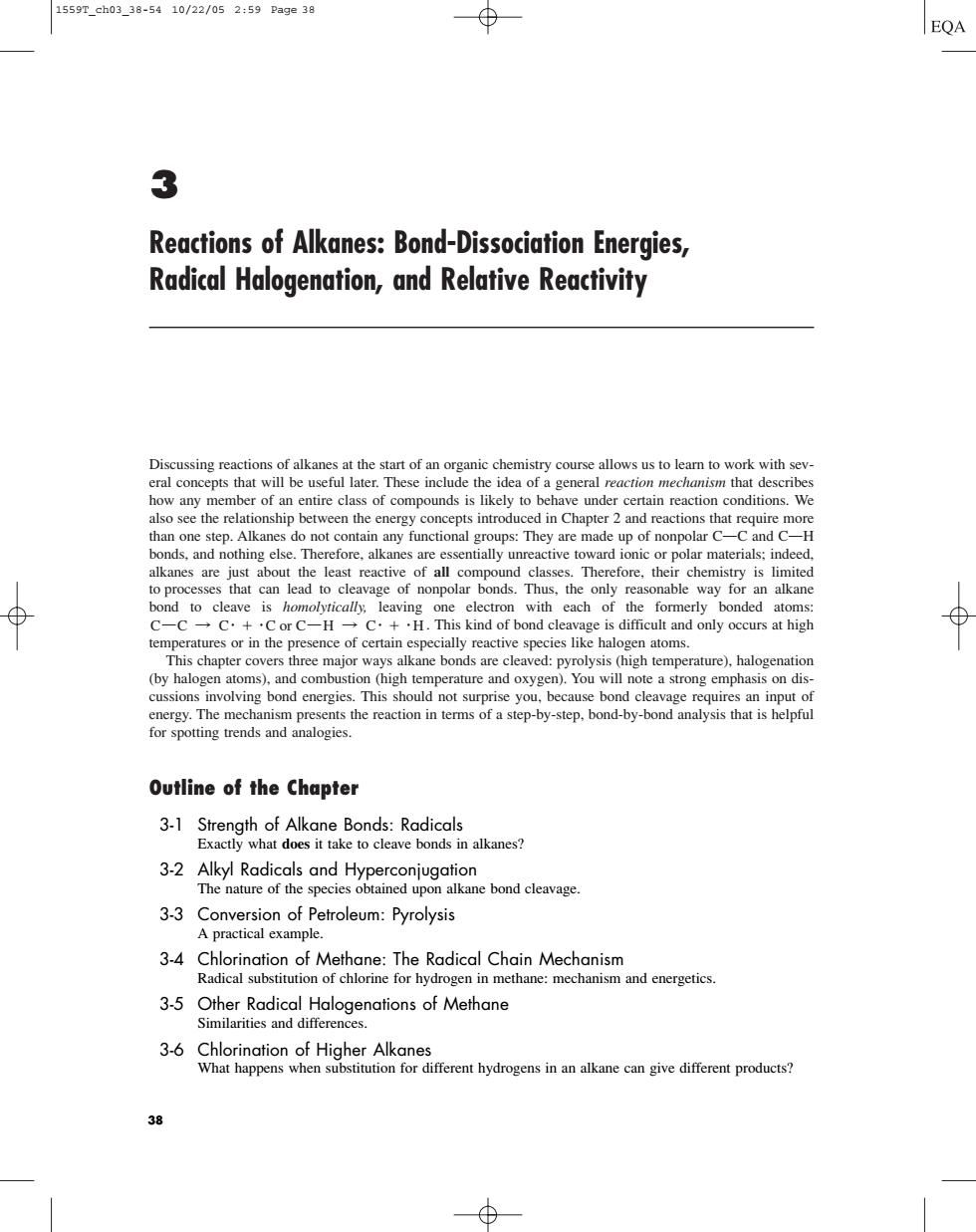正在加载图片...

1559Tch0338-5410/22/052:59Page38 EQA 3 Reactions of Alkanes:Bond-Dissociation Energies, Radical Halogenation,and Relative Reactivity how any member of class of compoundsis likely to behave under certain reaction conditions.We ship between the energ ncepts introd in Chapter 2 and rea bonds.and nothing else Therefore alkanes are essentially unreactive toward ionic or polar materials:indeed alkanes are jst about the least reactive of all compound bond to cleave is leaving one electron with each of the formerly bonded atoms C-C→C·+·CorCH■ C.+H.This kind of bond cleavage is difficult and only occurs at high em s three n (by halo m),and combustion (high tcmperature and oygen Youill noteronmpha on dis- cussion ond energies aiepy-sep.boaayh be Outline of the Chapter 3-1 Strength of Alkane Bonds:Radicals Exactly what does it take to cleave bonds in alkanes? 3-2 Alkyl Radicals and Hyperconjugation The nature of the species obtained upon alkane bond cleavage. 3-3 Convers 3.4 Chlorination of Methane:The Radical Chain Mechanism Radical substitution of chlorine for hydrogen in methane:mechanism and energetics 3-5 Other Radical Halogenations of Methane Similarities and differences.3 Reactions of Alkanes: Bond-Dissociation Energies, Radical Halogenation, and Relative Reactivity Discussing reactions of alkanes at the start of an organic chemistry course allows us to learn to work with several concepts that will be useful later. These include the idea of a general reaction mechanism that describes how any member of an entire class of compounds is likely to behave under certain reaction conditions. We also see the relationship between the energy concepts introduced in Chapter 2 and reactions that require more than one step. Alkanes do not contain any functional groups: They are made up of nonpolar COC and COH bonds, and nothing else. Therefore, alkanes are essentially unreactive toward ionic or polar materials; indeed, alkanes are just about the least reactive of all compound classes. Therefore, their chemistry is limited to processes that can lead to cleavage of nonpolar bonds. Thus, the only reasonable way for an alkane bond to cleave is homolytically, leaving one electron with each of the formerly bonded atoms: . This kind of bond cleavage is difficult and only occurs at high temperatures or in the presence of certain especially reactive species like halogen atoms. This chapter covers three major ways alkane bonds are cleaved: pyrolysis (high temperature), halogenation (by halogen atoms), and combustion (high temperature and oxygen). You will note a strong emphasis on discussions involving bond energies. This should not surprise you, because bond cleavage requires an input of energy. The mechanism presents the reaction in terms of a step-by-step, bond-by-bond analysis that is helpful for spotting trends and analogies. Outline of the Chapter 33-1 Strength of Alkane Bonds: Radicals Exactly what does it take to cleave bonds in alkanes? 33-2 Alkyl Radicals and Hyperconjugation The nature of the species obtained upon alkane bond cleavage. 33-3 Conversion of Petroleum: Pyrolysis A practical example. 33-4 Chlorination of Methane: The Radical Chain Mechanism Radical substitution of chlorine for hydrogen in methane: mechanism and energetics. 33-5 Other Radical Halogenations of Methane Similarities and differences. 33-6 Chlorination of Higher Alkanes What happens when substitution for different hydrogens in an alkane can give different products? CC C H C or C C H 38 1559T_ch03_38-54 10/22/05 2:59 Page 38